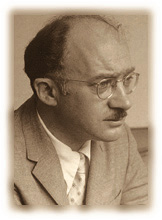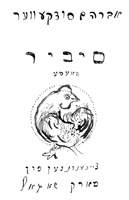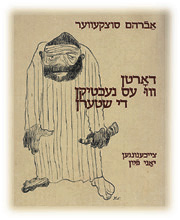![]()
Main Menu ·
Search ·
Current Issue · Contact · Archives · Centennial · Letters to the Editor · FAQs
![]()
Main Menu ·
Search ·
Current Issue · Contact · Archives · Centennial · Letters to the Editor · FAQs
| Previous... Also see What is Yiddish? and A Revival of Yiddish? |

|
| Turning point: Poet Abraham Sutzkever, survivor of Vilna, jolted Wisse into studying Yiddish. Shown here are his poem Siberia, illustrated by Marc Chagall (middle), and a collection of stories, Where Stars Spend the Night. |
 |
 |
 |
In The Schlemiel, Wisse formulates her lifelong preoccupation with the ambiguities of Jewish weakness--in this case, weakness in its adaptive mechanism of humor. "The classic expression of Yiddish irony," she writes, "is the saying: 'Ato bokhartonu mikol hoamim--vos hostu gevolt fun dayn folk yisroel? Thou hast chosen us from among the nations--why did you have to pick on the Jews?'" The first line borrows from sacred Hebrew text, the following line undercuts it in everyday Yiddish. "Yiddish irony," she continues, "often takes the form of statement and counterstatement, to the same effect. The dialectic was especially fertile in the vital field of economic theory: 'Rich and poor, both lie in the ground together, but on the ground the rich lie more comfortably,' or 'Imru l'adonoy [speak to the Lord] and talk to the wall.'"
She provides example after example of Yiddish irony and satire, illustrating them with characters from fiction. One of the most famous is Sholom Aleichem's exuberant bumbler, Menahem Mendl, whose "masculinity is never considered; it is thoroughly extinct. The traditional male virtues such as strength, courage, pride, fortitude, are prominent only in their absence." But as much as we may laugh at and with Menahem Mendl, his wife Sheyne Sheyndl's "descriptions of blood-spitting, sickly children, social ostracism, and vicious poverty emphasize the full price each family paid for a schlemiel as breadwinner."
The passivity of other schlemiels, like Singer's Gimpel the Fool, takes on a "deeper truth, deeper because it frees a man from despair, permits him to live in harmony with his conscience, to practice goodness, and hope for justice." On the other hand, though readers have traditionally read Isaac Leib Peretz's famous story "Bontshe the Silent" as a bittersweet tale of saintliness, Wisse describes it as "actually a socialist's exposure of the grotesquerie of suffering silence."
A few years ago, Wisse wrote her book I.L. Peretz and the Making of Modern Jewish Culture, which Martin Peretz, a scion of the line, has called "the best book on Peretz in the English language, bar none," hailing its "bracing lack of sentimentality," a view echoed by scholars like Janet Hadda, professor of Yiddish at UCLA. In the book, Wisse elaborates on the subject of Bontshe, the pitiful nobody whose living and dying "made no impression." After a lifetime of abuse, poverty, and subhuman deprivation, Bontshe finally makes it to heaven. There, when all the choirs of angels and the heavenly judge himself tell Bontshe he can at last, finally, truly ask for anything in all of heaven and earth, Bontshe smiles meekly and says, "Well, then, what I'd like most of all is a warm roll with fresh butter every morning."
Can there be any doubt [asks Wisse] of the story's political thrust? In the figure of Bontshe, Peretz challenges the ideal of goodness that had a powerful grip on the folk imagination....Everything works schematically as it should, except that this creature is beyond redemption. His soul is too meek and his outlook too narrow to make possible any ultimate restitution. Bontshe's failure to develop a character in the material world destroys any chance of postponed spiritual life. The moral scheme that makes a hero of Bontshe is itself morally flawed.
 Another work that she touches on in Schlemiel, but which she has returned to repeatedly, most recently in her Harvard course "Literature and Politics: The Case of Zionism," is Chaim Nahman Bialik's long and harrowing poem, "The City of Slaughter." Written first in Hebrew, then in Yiddish, the poem originated in Bialik's trip to the Russian town of Kishinev to document the ravages of the pogrom of 1903. The result was a tapestry of horror--but also a withering condemnation. It became ultimately one of the rallying texts of Jewish self-defense and of Zionism.
Another work that she touches on in Schlemiel, but which she has returned to repeatedly, most recently in her Harvard course "Literature and Politics: The Case of Zionism," is Chaim Nahman Bialik's long and harrowing poem, "The City of Slaughter." Written first in Hebrew, then in Yiddish, the poem originated in Bialik's trip to the Russian town of Kishinev to document the ravages of the pogrom of 1903. The result was a tapestry of horror--but also a withering condemnation. It became ultimately one of the rallying texts of Jewish self-defense and of Zionism.
Arise and go now to the city of slaughter;
Into its courtyards wind thy way;
There with thine own hand touch, and with the eyes of
thine head,
Behold on tree, on stone, on fence, on mural clay,
The spattered blood and dried brains of the dead....Then wilt thou flee to a yard, observe its mound.
Upon the mound lie two, and both are headless--
A Jew and his hound....A tale unfold horrific to the ear of man:
A tale of cloven belly, feather-filled;
Of nostrils nailed, of skull-bones bashed and spilled;
Of murdered men who from the beams were hung,
And of a babe beside its mother flung....
Note also, do not fail to note,
In that dark corner, and behind that cask
Crouched husbands, bridegrooms, brothers, peering from
the cracks....Come, now, and I will bring thee to their lairs
The privies, jakes, and pigpens where the heirs
Of Hasmoneans lay, with trembling knees,
Concealed and cowering--the sons of the Maccabees!*
Is Bialik--despite real-life instances of Jewish resistance--tracing what he sees as the Jew's pathetic slide from the Maccabean lion to the craven schlemiel hiding in the privy while "the lecherous rabble" raped his wife and daughters?
On the one hand, yes. "What Bialik saw was a frightened pacifism that was like an undertow sapping Jewish morale," says Wisse. "But on the other hand, we must remember that Jews had no military tradition at all; having made a virtue of playing the schlemiel in political history, they could only fear becoming the corpse.
"The Jews were demonized and targeted for extinction by Germans, Lithuanians, Ukrainians, Poles, Russians, and a long list of others. Why? Where else in history has such a tiny people been the focus of so much unilateral, irrational hatred? Now, unilateral hatred can be withstood only if it is challenged with sufficient force. But how can the victim of such hatred mount a sufficient counterattack if he lacks even the instinct of reciprocal aggression?"
The retreat from violence was even embedded in the Jewish language, she recalls. "Max Weinreich once traced for me the following history of the Yiddish term hargenen, 'to kill.' Enjoying no active use among the Jews of Europe, the term gradually acquired the weaker meaning to 'strike,' or 'beat,' while to signify real killing one said derhargenen, employing a prefix for an action seen through to its end. But this stronger term, too, came to mean no more than 'beat,' or 'rough up,' and for killing one resorted to derhargenen oyf toyt--'to kill to death.'"
Ultimately, in the teeth of pervasive bestiality, Yiddish literature, as poet Itzik Manger noted, revealed itself as "the last humanistic bolt of light on a dark continent that had once boasted of its culture and civilization." Though many Jews had grown apart from their ritual practices, Yiddish--what American poet and novelist Jacob Glatstein called "the warm fiddle of wise and understanding Yiddish"--became, says Wisse, "the repository of a civilizing alternative to the threatening barbarism of Europe...and writers could turn from the contemporary horror... to the sweet dignity of politically innocent fathers and mothers." However, this "yiddishism" carried with it profound self-delusion. For one thing, it "suggested to the Jews," says Wisse, "that they could continue to exist in Europe and elsewhere as autonomous cultural communities alongside of, but still unabsorbed by, their neighbors. It was," she continues, "conceptually utopian in its expectation that Jews could continue to maintain their exceptional character through the ersatz-motherland of culture." Not only did many Jews misguidedly equate a secular Yiddishkeyt, completely divested of ritual and law, with mentshlekhkeyt, humaneness, investing it with the full spiritual value of Jewishness; but even more tragically, they "attributed to it quasi-territorial status."
Main Menu ·
Search · Current Issue · Contact · Archives · Centennial · Letters to the Editor · FAQs
![]()